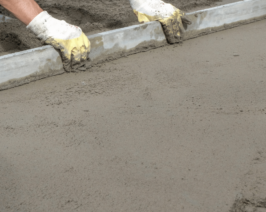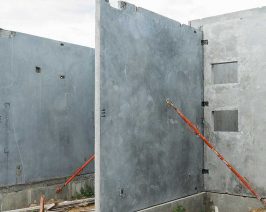CCS Petrol Resistant Sealer is formulated with a tough resin that does not soften when exposed to intermittent petrol spillage. In contrast, conventional acrylic sealers will soften and emulsify when petrol is spilt on them, causing the surface to become tacky and slippery.
Designed as a minimum two coat system, Petrol Resistant Sealer provides excellent protection against the fading or leeching of oxides in concrete, and staining or marking due to contaminants including grease, oil and dirt.
CCS Petrol Resistant Sealer has been specially formulated for service stations, workshops and factory floors where petrol and chemical spills can be hazardous with conventional concrete sealers.
Recommended Uses
- Plain, coloured and stencilled concrete
- Stamped/patterned concrete
- CCS Stylepave or ‘sprayed-on’ concrete
Colours
- Clear
- Shale Grey
- Black
Coverage
Coverage is approximately 4–5m2 per litre per coat. Where two coats are applied, coverage is approximately 40–50m2 per 20 litre drum. Refer to the chart below for first coat dilution rates. Always dilute with CCS Solvent.
Coverage based on finish
| Concrete Finish | Solvent : Sealer |
| Stencil | 1 litre : 4 litres |
| Smooth or pattern | 1 litre : 4 litres |
| Spray-on resurfacing | If required |
Application Method
Best results are achieved by using a CCS Solvent Resistant Broom Head. A low pressure sprayer or roller can also be used, however penetration into the concrete is not as effective.
Allow freshly laid concrete that has been treated with CCS Same Day Sealer to cure for at least 7 days prior to application of sealer.
Fresh concrete that has not been treated with CCS Same Day Sealer or a curing agent should be left to cure for a minimum of 28 days prior to application. Do not apply to concrete that has a patchy appearance.
Preparation
Existing Concrete
To ensure all surface contaminants are removed, apply CCS HD Degreaser or CCS Citric Cleaner to the surface, ensuring the removal all oil stains.
Scrub the surface with auto scrubbing equipment or use a high pressure water cleaner to remove contaminants, ensuring all traces of the degreaser are thoroughly removed.
New Concrete
Fresh concrete that has not been treated with CCS Same Day Sealer or a curing agent should be left to cure for a minimum of 28 days prior to application.
Remove all oil, grease and dirt using CCS HD Degreaser. Then thoroughly wash the surface using auto scrubbing equipment or a commercial high pressure water cleaner. Ensure the concrete surface is clean and dry. Application of the sealer to moist concrete may cause the sealer to turn a white colour.
Where efflorescence or laitance is present, a mild citric cleaner wash may be required. Use CCS Citric Cleaner as per the label and data sheet instructions.
All concrete surfaces must be thoroughly dry before applying any sealer.
Resealing Concrete
Concrete surfaces that have previously been sealed with a solvent based acrylic sealer must be prepared by removing all loose and/or delaminated material.
Solvent scrub with CCS Solvent prior to immediate application of diluted CCS Petrol Resistant Sealer.
If the existing sealer is flaking / peeling, it is necessary to completely remove the coating with CCS Enviro Stripper. Ensure the surface is thoroughly rinsed and dry before applying any sealer.
First Coat
- The first coat should be diluted as per table above. A minimum of 2 coats should be applied to concrete.
- To apply, use a CCS Solvent Resistant Broom Head, short napped roller or a solvent resistant low-pressure sprayer.
Spread the sealer over the entire surface in an even and systematic way so that the concrete is completely covered. If ‘pooling’ occurs, immediately spread the accumulated sealer. - Allow a minimum of six hours between coats. For best results, allow 24 hours before applying the final coat.
Second Coat
- Stir thoroughly and apply as per first coat method above,
however thinning is not required. - Apply the second coat in the opposite direction to the first coat.
- A traction aid such as CCS Sealer Grit can be added on the final coat.
Clean up
Wash all equipment thoroughly in CCS Solvent and allow to dry.
Curing
Curing time depends on the temperature. The sealer is usually touch-dry in 20 minutes at 25ºC. The concrete can usually be walked on after 24 hours. Allow 7 days before allowing vehicular traffic.
NOTE: CCS Petrol Resistant Sealer should not be used as a curing compound.
Appropriate Surface Texture
Generally, applying a coating to concrete will reduce the existing slip resistance of that surface.
Consequently, care must be taken before sealing concrete to ensure that the surface texture has sufficient profile to provide adequate traction.
To aid traction, mix a satchel of CCS Sealer Grip additive into the sealer prior to application of the final coat. However, as the sealer wears, the traction additives will also diminish in effectiveness.
Coating Maintenance and lifespan
The expected lifespan of the coating is dependent on the location, weather and traffic the concrete is subjected to.
One major benefit of all CCS solvent based sealers is the ease of re-coating.
Assess the surface after 12 months, 18 months and 24 months from the date of application to determine if it requires recoating. In light use areas that are protected from adverse weather conditions, the coating will last much longer.
Downloads
Features and Benefits
- Does not soften when exposed to petrol and chemical spills
- Specially formulated for service stations, workshops and factory floors
- Available in three colours: Clear, Shale Grey & Black
Packaging
CCS Petrol Resistant Sealer is available in 20 litre drum.
For further information consult the Safety Data Sheet (SDS) and read the Technical Data Sheet (TDS) carefully before use. SDS and TDS documents are available in the Resources section of this website and by contacting ACS Customer Service support line on 1800 077 744.






